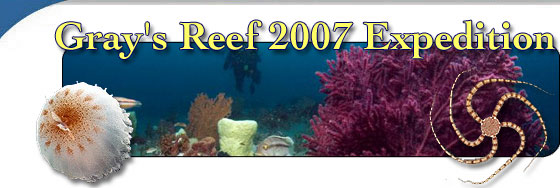Mission Log: June 16, 2007
Dr. Danny Gleason
Professor, Georgia Southern University
 |
| Gleason |
Although many people may not realize it, scientific endeavors sometimes have to be adjusted to take recreational pursuits by the general public into consideration. Today was such a day. With a king mackerel tournament taking place off the coast of Georgia our entire science team knew that it would not be a good day to conduct research in Gray’s Reef or at other popular fishing spots frequented along the Georgia coast. These areas would just be too crowded. Given this, we headed a little farther offshore to the R-2 tower to “avoid the crowds.” This tower is one of six former Navy towers along the coast that was used previously to train Navy pilots. Now these towers serve various functions including sites for mounting weather and oceanographic instrumentation.
In addition to getting away from the crowds, there was another reason for making a trek to the R-2 tower – clearer water with better visibility! For the last several days we have been trying to complete work in unusually murky water conditions. Although our attempts to work under water have been successful, clearly everyone was ready for a change. So after a successful night of sub-bottom profiling in Gray’s Reef by Paul Gayes and company, the Nancy Foster set a course for the R-2 tower.
We made 2 dives at R-2, one on a hard bottom area that has fairly low rocky relief of 1-2 feet and the second on the pilings of the tower. The bottom at both of these sites was in excess of 90 feet depth so our bottom time was somewhat limited. Furthermore, to avoid having any type of diving accident, such as the bends, we were required to stay out of the water for at least 3 hours between dives.
 |
|
Researchers spot a Lionfish at the R-2 dive site. (Photo: Gray's Reef National Marine Sanctuary)
|
On the first dive I, along with Rob Ruzicka, Stephanie Schopmeyer, and Hampton Harbin replaced PVC tube traps that we had deployed in the previous year. These traps were very simple and consisted of either 2 inch or ¾ inch diameter x 12 inch length PVC tubes. The idea behind these traps is that they will provide homes for many species of invertebrates and cryptic fishes that will settle in them over time. We retrieve these traps periodically looking for species that are not represented in our museum collection of bottom-dwelling invertebrates and cryptic fishes. This time we found 3 or 4 new invertebrates for our collection, but one of the biggest surprises was a reticulated moray a little more than a foot long that had decided to take up residence in one of our tubes. As it tried to slither away, Rob was able to guide it into one of our zip-loc bags. Though we realized that this species of moray was already represented in our collection we decided to take it to the surface to show the crew and other scientists. After everyone had a chance to marvel at the moray, we released him back to the sea.
While we were collecting the tube traps, Greg McFall, Scott Noakes, and David Grenda cruised the area making fish counts, taking photos, and scouring the bottom for any fossil remains. While they were excited to see a couple of Pacific lionfish this was also a disappointment because lionfish are an introduced species and seem to be well established off the coast of Georgia. They also encountered numerous amber jack, sheepshead, porgies, gag grouper, red snapper, and even a bat fish, just to name a few. All in all, it was a successful dive at the R-2 hard bottom site.
 |
|
A close-up of the Seaweed Blenny. (Photo: Gray's Reef National Marine Sanctuary)
|
In the afternoon we moved over to the actual tower and made a dive on the pilings. This was treated as an exploratory dive to look for any unusual invertebrates and conduct more fish counts. The invertebrates encrusting the pilings were enormous and very healthy. These pilings were covered with large vase sponges, soft corals, and all kinds of sea squirts. The diversity of invertebrates was excellent. Fish were also abundant and included barracuda, amber jack, snapper, Atlantic ray, and gag and scamp grouper. Greg, Dave, and Scott also spotted a nurse shark. A real treat for all of us was a large loggerhead turtle that was resting under a horizontal support at the base of the tower. This turtle was at least 3 feet long and was very relaxed allowing us to take his picture multiple times.
All-in-all, it was a great day. The seas are starting to calm down and we are hopeful that the visibility at Gray’s Reef and other sites inshore of R-2 will continue to improve. Tomorrow it is back to J-reef to complete set-up of plots that we will monitor well into the future. The crew of the Nancy Foster has been extremely helpful throughout and we are certainly not starving, so life is good off the coast of Georgia!
|



